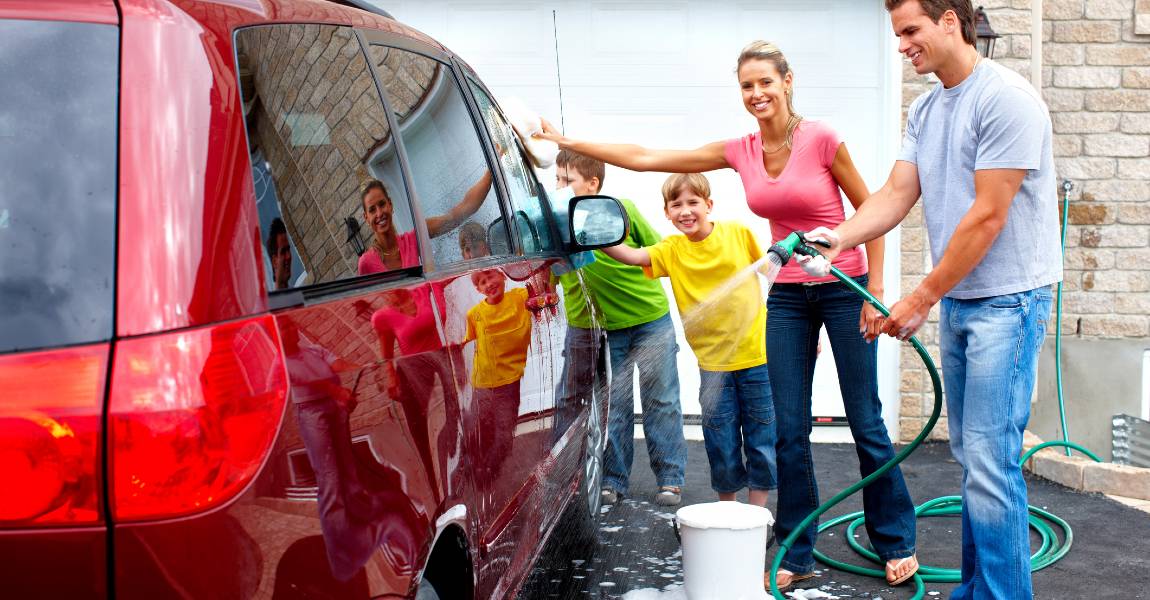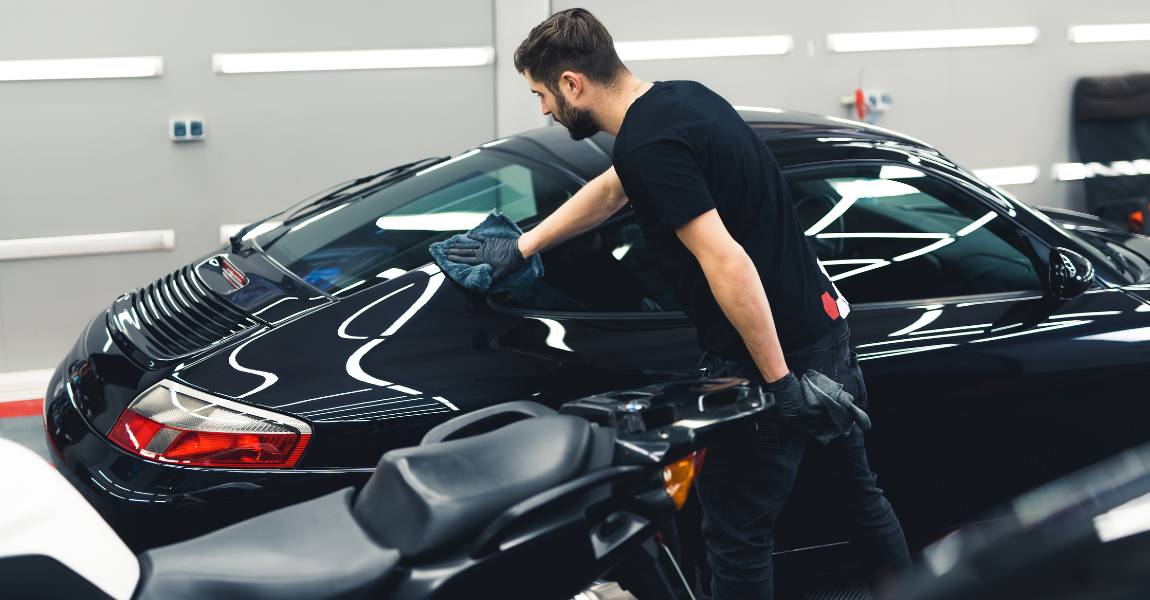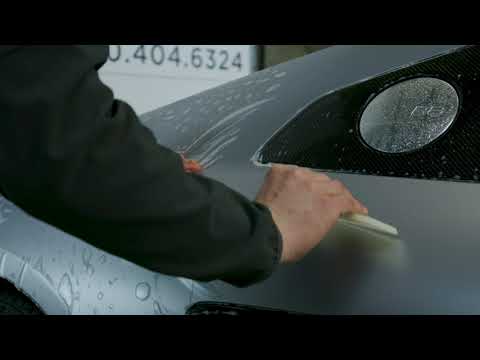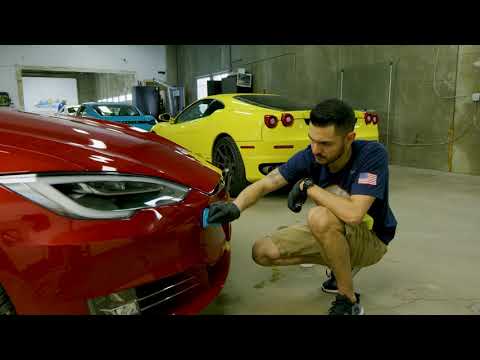If you’re a car enthusiast or want to keep your car looking brand new, you may have heard of ceramic coating. But how long does ceramic coating last on your car, and is it worth the investment?
Ceramic coating is a popular protective coating for cars that can help keep your car looking shiny and new for years to come. But with all the different options out there, it can be hard to know which one to choose and whether it’s worth the investment.
This blog post will explore the benefits of ceramic coating for cars, how long it typically lasts, and whether it’s worth the cost. By the end of this article, you’ll better understand whether it is the right choice for your car.

- What are Ceramic Coatings for Cars?
- What is the Lifespan of Ceramic Coating?
- Tips to Extend its Life
- Why do Ceramic Coatings Wear out Quickly?
- Maintenance to Prevent Damage
- When Should You Replace Ceramic Car Coating?
- FAQ’s
- Conclusion
What are Ceramic Coatings for Cars?
Ceramic coatings are a protective layer of protection for the car’s paint job that is applied as a liquid and then hardened to create a protective shield. They are made up of tiny particles of titanium dioxide, a solid and durable material resistant to scratches, bird droppings, tree sap, and other environmental factors. High-quality nano-ceramic-coatings can protect against UV rays, eliminate water spots, and even reduce dirt buildups.
The lifespan of ceramic coating on cars is highly dependent on the quality of the product, the proper ceramic coating application process, and general environmental factors.
Typically, a high-quality nano-ceramic coating can last up to five years with proper maintenance. However, it may begin to deteriorate over time due to extreme weather conditions and environmental deterioration
What are the Different Types of Ceramic Coating?
Ceramic coating products have become increasingly popular among car enthusiasts and detailers as they offer a range of benefits, including superior protection and longevity for a vehicle’s paintwork. Several different types of options are available on the market, each with unique properties and application methods.
One type of ceramic coating is ceramic paint coating, which is a durable, long-lasting coating solution that provides exceptional protection against scratches, UV rays, and other environmental factors. Professional detailers typically apply ceramic paint coatings, as they require a high level of skill and expertise to ensure a flawless finish.
Another option is ceramic coating boosters, designed to enhance the existing ceramic coatings’ performance by increasing their durability and hydrophobic properties.
Ceramic coating kits are also available for those who want to apply the coating themselves, typically including a ceramic spray coating and other proper tools and materials.
The nano-ceramic coating is a newer type of ceramic coating that uses nanotechnology to create a thin, transparent layer of protection that is highly resistant to scratches, acid rain, and other contaminants.
Finally, professional-only coatings require specialized equipment and training to apply and are typically used by high-end detailers and automotive manufacturers. Regardless of the type of ceramic coating chosen, they all offer superior protection and durability compared to traditional wax or sealant products.
What is the Lifespan of Ceramic Coating?
Ceramic coating has become increasingly popular in recent years due to its ability to protect a car’s paint and provide a long-lasting shine. But how long does ceramic coating last, and how can you extend its life?
The quality of the coating and maintenance determines the lifespan of ceramic coating.
The lifespan of a high-quality ceramic coating can range from 2 to 5 years with proper care.
However, some coatings can last up to 10 years or more. It’s important to note that ceramic coating is not a permanent solution and will eventually wear off over time.
Regular maintenance, such as applying a ceramic booster or sealant, can also help to extend the life of the coating. By taking proper care of your ceramic coating, you can ensure that it remains effective in protecting your vehicle’s paint and providing a beautiful shine for years to come.

Tips to Extend its Life
To extend the life of your ceramic coating, there are a few tips you can follow:
- Wash your car regularly: Regular washing helps to remove dirt and road debris that can scratch the exterior surface of the car. Use a pH-neutral car wash soap and avoid using harsh chemicals or abrasive tools.
- Avoid parking under direct sunlight: UV rays can damage the coating over time, so try to park in a shaded area or use a car cover.
- Use a ceramic coating maintenance spray: These sprays help to replenish the coating’s hydrophobic properties and provide extra protection.
- Don’t use automated car washes: These can be too harsh on the coating and cause it to wear off faster. Instead, hand wash your car or take it to a professional detailer.
- Apply ceramic coating boosters: Some paint protection can be reapplied or “boosted” after a certain amount of time to extend their life. Check with the manufacturer for specific recommendations.
In summary, this is an excellent investment for protecting your car’s paint and providing a long-lasting shine. By following the tips above, you can extend the life of your ceramic coating and keep your car looking its best for years to come.
Why do Ceramic Coatings Wear out Quickly?
Ceramic coatings are popular among car enthusiasts because they provide a layer of protection against scratches, UV rays, and other elements that can damage a vehicle’s paint job. However, ceramic coatings can wear out quickly if they are not applied or maintained properly. There are several reasons why ceramic coatings wear out quickly, including:
1. Improper application: If a ceramic coating is not applied correctly, it may not bond properly to the surface of the car. This can cause the coating to wear off more quickly than it should.
2. Environmental factors: Ceramic coatings can be damaged by exposure to extreme temperatures, harsh chemicals, and other environmental factors. For example, if a car is regularly exposed to salt water or acid rain, it may wear out more quickly than it would in a milder climate.
3. Lack of routine maintenance: Even the best ceramic coatings require regular maintenance to stay in good condition. If a car owner does not wash and maintain their vehicle regularly, it may wear out more quickly than it should.
In addition to these factors, it’s important to note that ceramic coatings are not permanent solutions. While they can provide long-lasting protection for a car’s paint job, they will eventually wear out over time. Car owners should be prepared to reapply the coating every few years to maintain its effectiveness.
Maintenance to Prevent Damage
Ceramic coatings are popular for protecting car paint from damage and wear. However, like any other coating, it requires maintenance to ensure that it lasts for its intended lifespan. Failure to properly maintain it can lead to it wearing off and exposing the paint to damage.
Here are some tips on maintaining ceramic coatings to prevent wear and damage.
Firstly, using the right maintenance products is essential. Using harsh chemicals or abrasive tools can damage it and strip it off the paint. Instead, use pH-neutral products that are specially formulated for ceramic coatings. These products are gentle on the coating and help to maintain its protective properties. Some common maintenance products for ceramic coatings include waterless washes, detail sprays, and drying aids.
Secondly, regular washing is essential for maintaining ceramic coatings. Dirt and grime can build up on the ceramic, making it less effective at protecting the paint. Regular washing helps to remove these contaminants and keep it clean. Wash The car using a pH-neutral shampoo and a microfiber wash mitt to avoid scratching the coating. Rinse the car thoroughly with water and dry it using a soft microfiber towel or drying aid.
Lastly, avoid exposing the car to harsh conditions that can damage the coating. High temperatures, harsh chemicals, and abrasive materials can all cause the coating to wear off and expose the paint to damage.
To maintain the condition of your car, it is recommended to refrain from parking it under direct sunlight for long periods and use harsh chemicals or abrasive tools when washing it. Instead, park the car in a shaded area, and use gentle maintenance products to clean it. Always avoid harsh weather conditions.
In summary, here are some bullet points on how to maintain ceramic coatings to prevent wear and damage:
- Use pH-neutral maintenance products that are specially formulated for ceramic car coatings
- Regularly wash the car using a microfiber wash mitt and a pH-neutral shampoo
- Avoid exposing the car to extreme conditions that can cause damage, such as high temperatures and harsh chemicals
- Dry the car using soft microfiber cloths or a drying aid
- Park the car in a shaded area to avoid exposure to direct sunlight
- Avoid using abrasive tools or harsh chemicals to clean the vehicle.

When Should You Replace Ceramic Car Coating?
Ceramic car coatings are commonly used to safeguard a car’s paint job and maintain its fresh appearance. Nevertheless, even top-quality coatings will ultimately deteriorate and become less effective. Here are some signs that it may be time to replace your ceramic car coating:
- Your car’s paint has lost its shine: Over time, even the best ceramic coatings can become dull and lose their shine. If your car’s paint no longer looks as vibrant as it once did, it may be time to replace your coating.
- Your car’s paint is no longer water-repellent: One of the main benefits of ceramic coatings is that they make your car’s paint water-repellent. It may be time to replace your coating if you notice that water is no longer beading up on your car’s surface.
- Your car’s paint is starting to show signs of damage: Ceramic coatings are designed to protect your car’s paint from damage, but they can’t prevent it entirely. If you notice scratches;, swirl marks, or other signs of damage on your car’s paint, it may be time to replace it.
Pros of Replacing Ceramic Coating:
- Restores your car’s paint to its original shine and luster
- Provides renewed protection against scratches, UV rays and other forms of damage
- Improves the water-repellent properties of your car’s paint
Cons of Replacing Ceramic Coating:
- Can be expensive, depending on the size of your car and the type of coating you choose
- Requires the old coating to be removed, which can be time-consuming and labor-intensive
- May not be necessary if your car’s paint is still in good condition is only slightly worn down.
Key Takeaways:
1. Ceramic car coatings last an average of one to five years before needing to be replaced, depending upon the type of coating used and the amount it has been exposed to environmental elements such as UV radiation.
2. Studies show that an excellent ceramic car coating can protect a vehicle’s paint for up to seven years or longer with proper care and maintenance.
3. Over time, exposure to ultraviolet rays and acid rain can degrade a ceramic car coating, causing it to become dull, chip away, or even peel off in some cases.
4. If you want your vehicle to look new all the time, then a regular waxing every six months is recommended for long-lasting results, with most ceramic coatings lasting between two and four washes on average before needing re-coating.
5. It’s important to note that ceramic car coatings need not just provide gloss; they have additional advantages, such as providing protection from UV fading that waxes alone cannot offer, making them well worth the investment.
6. Experts recommend that you check your vehicle’s interior and exterior for signs of wear and tear every 3-4 months if you want maximum protection for your car – this way, you can spot when you might need to reapply the chemical complement needed for full protection against minor scratches as well as strong winds chaffing, dirt accumulation and extreme weather conditions (like freezing snow or hot summer days).
FAQ’s
1. What is ceramic coating?
A: Ceramic coating is a liquid polymer applied to a car’s exterior to protect the paint from scratches, UV damage, and other environmental factors.
2. How long will it last on a car?
A: The lifespan can vary depending on the quality of the product and how well it is applied. Generally, ceramic car coatings can last anywhere from 2 to 5 years.
3. What factors affect the longevity of ceramic coating on a car?
A: Factors that can affect the lifespan include the quality of the product, the condition of the car’s paint, how well the coating is applied, and how the car is maintained after applying.
4. Can you apply this yourself, or should you hire a professional?
A: While it is possible to apply this yourself, it is recommended to hire a professional to ensure that it is applied correctly and evenly. This can help to maximize the lifespan.
5. How can you maintain the longevity on your car?
A: To maintain the longevity, washing and maintaining your car’s exterior regularly is essential. Avoid using harsh chemicals or abrasive materials that can do damage. Additionally, it is recommended to have this reapplied every 2 to 3 years to ensure continued maximum protection.
Conclusion
In conclusion, it is an excellent investment for car owners who want to protect their vehicles from harsh environmental elements and maintain their appearance.
The longevity will vary depending on the quality of the product and how well it is maintained, but it can last up to 2-5 years with proper care. To ensure that your vehicle’s coating lasts as long as possible, it’s essential to follow the manufacturer’s instructions for maintenance and avoid harsh chemicals or abrasive materials when cleaning your car.
If you’re interested in having this service done for your car, do your research and choose a reputable product and qualified installer. Your car will thank you for the extra layer of protection and shine!
Contact Colorado Clear Bra today at 720-404-6324 to learn more and schedule an appointment with a professional ceramic coating services installer.




